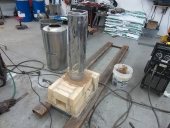








"We're all just walking each other home." -Ram Dass
"Be a lamp, or a lifeboat, or a ladder."-Rumi
"It's all one song!" -Neil Young
 1
1




An important distinction: Permaculture is not the same kind of gardening as organic gardening.
Mediterranean climate hugel trenches, fabuluous clay soil high in nutrients, self-watering containers with hugel layers, keyhole composting with low hugel raised beds, thick Back to Eden Wood chips mulch (distinguished from Bark chips), using as many native plants as possible....all drought tolerant.




Cristo Balete wrote:
The batteries need to be in a different shed from the controller and inverter because they off-gas and will eat away at delicate equipment, so we're talking two sheds and a set of panels.
Plans are only good intentions unless they immediately degenerate into hard work -Peter Drucker








An important distinction: Permaculture is not the same kind of gardening as organic gardening.
Mediterranean climate hugel trenches, fabuluous clay soil high in nutrients, self-watering containers with hugel layers, keyhole composting with low hugel raised beds, thick Back to Eden Wood chips mulch (distinguished from Bark chips), using as many native plants as possible....all drought tolerant.




An important distinction: Permaculture is not the same kind of gardening as organic gardening.
Mediterranean climate hugel trenches, fabuluous clay soil high in nutrients, self-watering containers with hugel layers, keyhole composting with low hugel raised beds, thick Back to Eden Wood chips mulch (distinguished from Bark chips), using as many native plants as possible....all drought tolerant.





An important distinction: Permaculture is not the same kind of gardening as organic gardening.
Mediterranean climate hugel trenches, fabuluous clay soil high in nutrients, self-watering containers with hugel layers, keyhole composting with low hugel raised beds, thick Back to Eden Wood chips mulch (distinguished from Bark chips), using as many native plants as possible....all drought tolerant.




An important distinction: Permaculture is not the same kind of gardening as organic gardening.
Mediterranean climate hugel trenches, fabuluous clay soil high in nutrients, self-watering containers with hugel layers, keyhole composting with low hugel raised beds, thick Back to Eden Wood chips mulch (distinguished from Bark chips), using as many native plants as possible....all drought tolerant.









An important distinction: Permaculture is not the same kind of gardening as organic gardening.
Mediterranean climate hugel trenches, fabuluous clay soil high in nutrients, self-watering containers with hugel layers, keyhole composting with low hugel raised beds, thick Back to Eden Wood chips mulch (distinguished from Bark chips), using as many native plants as possible....all drought tolerant.
 1
1









An important distinction: Permaculture is not the same kind of gardening as organic gardening.
Mediterranean climate hugel trenches, fabuluous clay soil high in nutrients, self-watering containers with hugel layers, keyhole composting with low hugel raised beds, thick Back to Eden Wood chips mulch (distinguished from Bark chips), using as many native plants as possible....all drought tolerant.




 In Our area power bills range from $250 up to $450/month through the year depending on current power rates (.09 to .15/Kw) and our fixed charges are at least 1/2 the bill. For example I paid under $500 in October for 500 Gallons of propane, I can heat my home and do allot of cooking for the year. Our wood costs in the area went from $240 a cord to $280 this year that is cut, split and delivered. We cut our own it just takes time and effort. Find the alternatives in your area, we also burn clean pallet wood that we pick up for free.
In Our area power bills range from $250 up to $450/month through the year depending on current power rates (.09 to .15/Kw) and our fixed charges are at least 1/2 the bill. For example I paid under $500 in October for 500 Gallons of propane, I can heat my home and do allot of cooking for the year. Our wood costs in the area went from $240 a cord to $280 this year that is cut, split and delivered. We cut our own it just takes time and effort. Find the alternatives in your area, we also burn clean pallet wood that we pick up for free.
My heroes are real people: These are the real Rock Stars: Sepp Holzer, Paul Wheaton, Geoff Lawton, Joel Salatin, Masanobu Fukuoka RIP, Larry korn, Toby Hemenway, Dr. Elaine Ingham, Gabe Brown, Vandana Shiva to name only a few.




 1
1









An important distinction: Permaculture is not the same kind of gardening as organic gardening.
Mediterranean climate hugel trenches, fabuluous clay soil high in nutrients, self-watering containers with hugel layers, keyhole composting with low hugel raised beds, thick Back to Eden Wood chips mulch (distinguished from Bark chips), using as many native plants as possible....all drought tolerant.









|
My cellmate was this tiny ad:
permaculture and gardener gifts (stocking stuffers?)
https://permies.com/wiki/permaculture-gifts-stocking-stuffers
|





